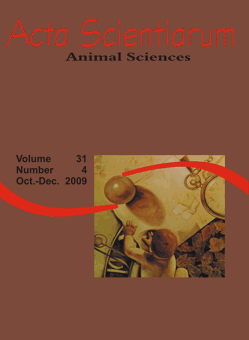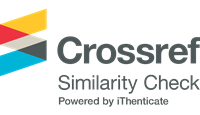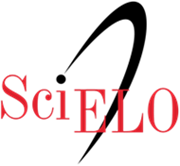<b>Performance and histochemical characteristics of the skeletal muscle tissue of lambs finished under different systems</b> - DOI: 10.4025/actascianimsci.v31i4.6410
Keywords:
performance, muscle fibers, modulation fibers
Abstract
Verify the effect of the termination system the forty-four ½ Dorset Santa Inês lambs in the frequency, diameter of skeletal muscular fibers and performance. Samples the semitendinosus muscle were collected for diameter analysis, frequency and modulation effect at weaning and slaughter. After weaned, the lambs were distributed in two finishing systems. Feedlot received ration (4% BW) with 15.56% of CP and 4.32 Mcal of GE kg-1 of DM, while those on pasture received supplementation (1.5% BW) with 27.01% CP and 4.51 Mcal of GE kg-1 of DM. The average daily gain (ADG) was 0.157 and 0.148 kg for feedlot (TF) and pasture + supplementation (PS). The diameters of skeletal muscle fibers SO, FOG and FG for TF and PS were 29.04 and 28.55, 34.46 and 35.80, and 38.81 and 40.96 µm, respectively. Frequency of skeletal muscle fibers SO, FOG and FG for TF and PS, were 19.32 and 21.35, 43.88 and 43.53, and 36.80 and 35.12%, respectively. Positive correlation was verified for lamb performance with the diameter, both for CT and PS. For the ADG variable, lambs could be either finished on TF or PS. The morphological and histochemical characteristics and modulation effect were similar, for either of the two finishing systems.Downloads
Download data is not yet available.
Published
2009-11-18
How to Cite
Santello, G. A., Macedo, F. de A. F. de, Dias, F. J., Mexia, A. A., Macedo, R. M. G., & Lourenço, F. J. (2009). <b>Performance and histochemical characteristics of the skeletal muscle tissue of lambs finished under different systems</b> - DOI: 10.4025/actascianimsci.v31i4.6410. Acta Scientiarum. Animal Sciences, 31(4), 425-431. https://doi.org/10.4025/actascianimsci.v31i4.6410
Issue
Section
Animal Production
DECLARATION OF ORIGINALITY AND COPYRIGHTS
- I Declare that current article is original and has not been submitted for publication, in part or in whole, to any other national or international journal.
The copyrights belong exclusively to the authors. Published content is licensed under Creative Commons Attribution 4.0 (CC BY 4.0) guidelines, which allows sharing (copy and distribution of the material in any medium or format) and adaptation (remix, transform, and build upon the material) for any purpose, even commercially, under the terms of attribution.
Read this link for further information on how to use CC BY 4.0 properly.
0.9
2019CiteScore
29th percentile
Powered by 








































